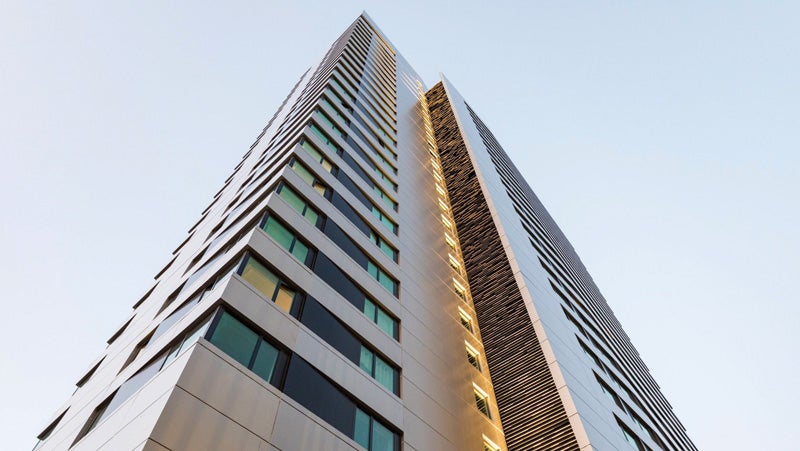As calls for action on climate change grow louder, attentions are turning to the building and construction industry. Buildings of every size emit carbon into the atmosphere from sources like heating and cooling, lighting and raw materials. The global impact is profound.
Research indicates that buildings produce about 42% of global greenhouse gas emissions in the world and account for 25% to 40% of total energy consumption - with demand growing exponentially.
Considering the data, it is abundantly clear that architects, designers and building product manufacturers have an important role to fill in preserving the future - and signs indicate that they are heeding the call.

The Industry is Rising to the Challenge
Architects and specifiers are helping to drive demand for more sustainable solutions aimed at reducing carbon footprints.
According to AIA research, 60% of architects consider sustainability at least half the time during product specification and 79% (97% for millennials) want to specify more sustainable materials in the future than they do today.
Leading coatings manufacturers like PPG are making significant investments in R&D to accelerate the development of new solutions that not only make buildings more resilient under the most extreme conditions, but also help to reduce their impact on the environment.
Heat in the City
While temperatures are rising by varying degrees across the globe, never have the effects been more profound than in urban settings.
On average, cities tend to be 1-7°F warmer (0.55-3.85°C) than surrounding areas during the daytime and up to 5° warmer at night, a phenomenon called the Urban Heat Island effect.
These hotter microclimates occur for a multitude of reasons, including limited tree canopies for shade, more heat absorbing surfaces like concrete, less evaporation from water sources and vegetation, plus higher density populations and all the transportation and energy needs that come with them.
These urban hot spots create a greater demand for air-conditioning, which drives up energy consumption, energy costs, as well as smog and ozone pollution, which only compounds the effects.
Finding ways to lower the temperatures in cities is of primary importance for protecting both the health of the people who live in them and bending the global warming curve.
Advancements in Cool Coatings
One of the most important advancements in the industry is the development of cool coating technologies that incorporate infrared (IR)-reflective pigments.
The source of these pigments is either naturally occurring minerals like titanium dioxide or, more commonly, engineered inorganic compounds.
Compared to standard coatings, cool coatings have a higher degree of solar reflectance and thermal emittance, how quickly the substrate "sheds" sunlight and heat. The difference is significant.
A standard black pigment has a total solar reflectance (TSR) value of about 5%. But a black IR-reflective pigment reflects about 50% of infrared energy, increasing the TSR to the 25-30% range.
These coatings, commonly used on roofing and other metal building components, help to lower building temperatures and reduce the energy demands needed for cooling.
While cool coatings aren't new - PPG commercialized its first cool coating back in 2001 - advancements in pigment technologies have continued to drive up their value in terms of substrate protection, aesthetics and cooling performance.
While cooler, more energy-efficient buildings are important, IR-reflective pigments also help to preserve the structural integrity of the substrate by reducing corrosion, warping, thermal expansion and polymer degradation - protection that can extend the life cycle of the substrate.
Cool Coatings are A Smart Investment
The economic impact of cool coatings is significant, particularly for roofing.
According to the U.S. Department of Energy, a conventional roof can reach temperatures of 150°F (66°C) or more on a hot sunny day. Under the same conditions, a reflective roof could be up to 50°F (28°C) lower, which can dramatically decrease energy demands needed for cooling.
A California study cited by the Environmental Protection Agency found that cool roofing delivers an average yearly net savings of almost 50 cents per square foot over standard roofing, despite higher price materials and winter heating penalties.
Sustainability Is Beautiful
Today, architects and designers can embrace more energy-efficient and sustainable coatings solutions without sacrificing color and design.
Advancements in IR-reflective pigment technologies are increasingly coming into play with rising popularity of darker colors since they offset the heat absorption that typically comes with deeper hues.
Coatings companies like PPG are continuously developing new coating innovations that combine cooling, energy-saving benefits with more dynamic, on-trend aesthetics, including PPG DURANAR® ULTRA-Cool® and PPG DURASTAR® ULTRA-Cool® SMP coatings, as well as PPG DURANAR® VARI-Cool coatings that combine cooling with color-shifting pigments.

